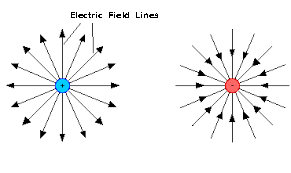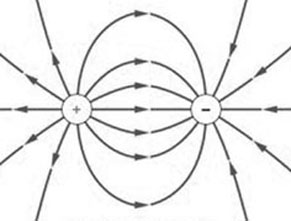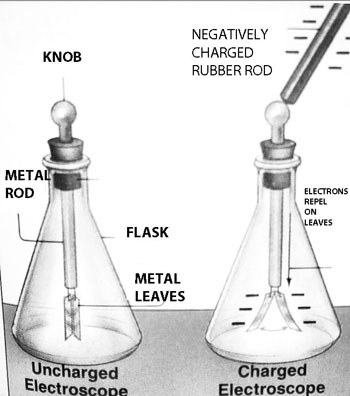Electric Charge and Electric Fields
Where does charge come from?
We know that all objects are made up of atoms and atoms are composed of smaller particles called protons, electrons and neutrons. Protons and neutrons are found in the nucleus of an atom and eletrons are found in an area outside often described as an electron cloud (see what are atomic orbitals for more advanced description). Remember that the hydrogen atom is only composed of a a single proton and electron. It does not contain a neutron.
Both protons and electrons have a basic property called charge. This property is not like other physical properties of matter. Charge however can be measured and it affects the behavior of particles.
The amount or magnitude of charge on protons is the same as electrons. The protons are positively charged, the electrons are negatively charged, and the neutrons are neutral.The terms positive charge and negative charge were originally described by Benjamin Franklin.
Charges exert Force
A force is defined as a push or pull. Charged particles exhibit similar behaviors of push and full. A force that pulls particles together is called an attractive force. So electrons are attracted to protons and this is what holds atoms together. A force that pushes apart particles is a repulsive force. Force of attraction exists between oppositely charged particles - electrons and protons are therefore attracted to each other. Similar charges will repel so negative electrons repel each other. The simple rule for electric charges is: Like chages repel each other and unlike charges attract each other.
What is an Electric Field?
The concept of an electric field is used to explain why charged particles exert forces on each other. When an electron moves into the electric field of a proton it is pulled to the proton. The electric field gets stronger as we approach the particle.
Electric fields are visualized by drawing extended lines as show in the image below. Note that for positive charge the field lines point outward and for negative field they point inward.
Electric Field lines between a positive and negative charge are shown below. As above the lines are drawn toward the negative charge.
What is an Electroscope and What is it Used For?
An electroscope is a scientific instrument that is used to detect the presence and magnitude of electric charge on a body. It was the first electrical measuring instrument. A typical classroom electroscope consists of a metal knob at top and a metal rod with thin metal leaves at the bottom. The rod is inserted into a flask with a rubber stopper (see image below). In an uncharged electroscope the leaves hang straight down. When a negatively charge object such as a negatively charged glass rod touches the knob the electric charge travels down the tube to the metal leaves. since both leaves now contain negative charges they will repel. Similarly if the knob is touch with a positively charged rod electrons will be drawn up the metal rod leaving positively charged leaves. The leaves again will repel.

Test your Understanding:
Electricity, Magnetism and Electromagnetism
- Electricity and Magnetism Home
- Electric Charge
- Coulombs Law and Inverse Square Law
- Static Electricity
- The Flow of Electricity
- Electric Current
- Electric Circuits
- Electric Power
- The Nature of Magnets
- Earth as a Magnet
- Magnetism in Action
- Magnetism from Electricity
- Electricity from Magnetism
- How do Transformers Work?
- Ohms Law Lab
- Magnetic Forces Lab
- Why Metals Conduct Electricity
- How does a Battery Work
- How does an Electric Motor Work
Science of Fluids
- Science of Fluids
- What are Fluids?
- What is Pressure?
- What is Hydrostatic Pressure?
- Surface Tension and Capillary Action
- Pascal's Principle
- Archimedes Principle
- What is Viscosity?
- Bernoulli's Principle